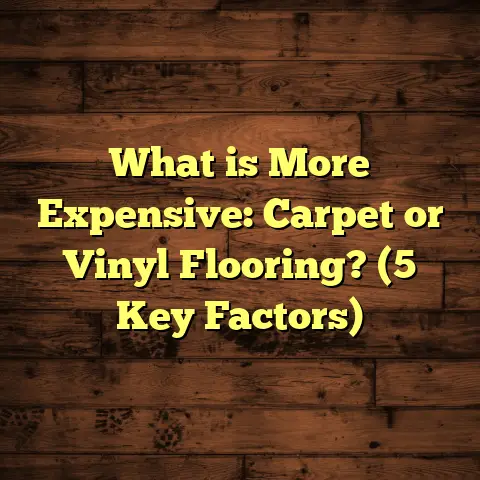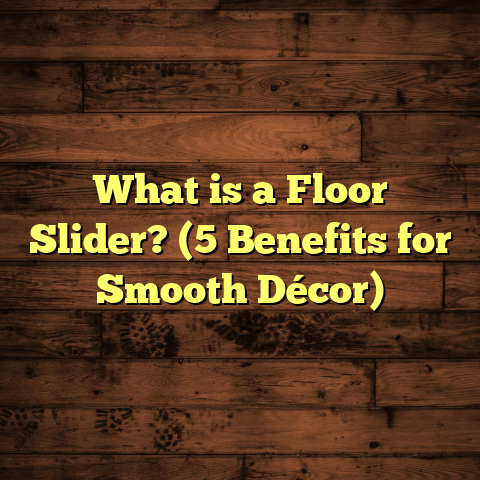What is Better: Laminate or Vinyl Flooring? (5 Key Comparisons)
Have you ever stopped to think about how your lifestyle shapes the kind of flooring you choose for your home? I mean, it’s not just about picking a pretty floor. It’s about what fits your daily life: the spills, the pets, the kids running around, the cleaning routines you can keep up with, and even how much time you want to spend on maintenance.
Over years of working as a flooring contractor and helping people remodel their homes, I’ve noticed that two options keep coming up in conversations: laminate and vinyl flooring. They both look great, and both can be budget- friendly alternatives to hardwood or tile. But which one actually works better for your needs? That question has been on my mind for a long time, and I’ve gathered plenty of insights from projects, research, and simply living with these floors myself.
So let’s talk about these two popular types of flooring, break down what each really is, and explore five key areas where they differ. I’ll share stories from my experience, data-backed facts, and even some tools that help me manage costs and make better choices on every job.
What Exactly Are Laminate and Vinyl Flooring?
Before comparing them head to head, it’s important to know what makes laminate and vinyl what they are.
Laminate flooring is basically a layered product. The heart of it is a strong core made from high-density fiberboard (HDF). On top of that core is a photographic layer — this is where the design comes in. It’s a high-res image that mimics natural materials like wood or stone. Finally, there’s a transparent wear layer on top that protects the floor from scratches, stains, and fading.
Vinyl flooring is made from synthetic plastic materials, mostly PVC. It comes in several forms: sheets, tiles, or planks. Each can feature printed designs to look like wood or stone too. What sets vinyl apart is its flexibility. It has a softer core than laminate and is naturally waterproof.
Both laminate and vinyl are designed to be budget-friendly, durable alternatives to more expensive flooring like hardwood. But they achieve their durability and looks differently.
When I first started out installing floors, I’d often hear clients say, “I want hardwood looks but without the price or maintenance.” Laminate and vinyl have filled that gap well, but with different strengths and weaknesses.
1. Durability and Resistance: How They Stand Up Over Time
One of the first things I ask customers is about how tough their floors need to be. Do you have young kids who love to run and jump? Pets that scratch or shed? What about moisture? Do you live in a humid area or have kitchens and bathrooms that get lots of spills?
These questions matter because laminate and vinyl react very differently to wear and water.
Laminate Flooring Durability
Laminate is known for its scratch resistance. The clear wear layer on top is designed to take quite a beating. I’ve seen laminate floors survive heavy foot traffic, furniture moves, and even some accidental drops without a scratch.
That said, laminate is not waterproof. Its core board will absorb water if exposed for too long. This causes swelling, warping, or sometimes bubbling in the planks. From my experience, laminate can handle quick spills if cleaned up right away but will fail if exposed to prolonged moisture.
A homeowner I worked with once had a spill under a coffee table that wasn’t noticed for days. The laminate swelled badly, and we had to replace a good portion of the floor in that area.
Still, for dry rooms like bedrooms or living rooms, laminate holds up very well over time. The scratch resistance means it keeps looking fresh longer than many other surfaces.
Vinyl Flooring Durability
Vinyl flooring scores big points for being waterproof. Because it’s made from plastic materials, it won’t absorb water. This makes vinyl ideal for kitchens, bathrooms, basements, or anywhere moisture is an issue.
Its flexibility also helps it resist cracking better than laminate. However, vinyl can be more prone to surface scratches compared to laminate’s tough wear layer. Still, modern luxury vinyl planks (LVP) have tougher surfaces than older vinyl styles.
I’ve installed vinyl floors in homes with active kids and pets, and after years of use, they still looked great with minimal wear. Plus, no worries about water damage means fewer repairs or stress.
Data You Can Trust
- Studies show laminate floors resist scratches up to three times better than standard vinyl.
- Vinyl flooring tolerates moisture exposure close to 100%, while laminate can only handle brief spillages before damage starts.
- On average, laminate floors last around 15 years in optimal conditions.
- Vinyl floors typically last 20 or more years thanks to their water resistance.
From a contractor’s point of view, if your environment involves moisture or high humidity, vinyl’s durability wins hands down. For dry spaces with high traffic but low moisture risk, laminate’s scratch resistance is excellent.
2. Appearance and Style: Which Looks Better?
How much does your floor contribute to your home’s vibe? A lot! And style options have come a long way for both laminate and vinyl.
Laminate Flooring Style
Laminate uses printed designs that mimic wood grain patterns, stone textures, and other natural looks. This printing technology has improved so much that many laminates look pretty close to real wood at first glance.
But since laminate has a flat surface with a subtle shine, it can sometimes look less natural when you get close. Still, if you want consistent wood tones like oak or maple, laminate offers tons of options—light woods, dark woods, rustic textures—you name it.
One client who renovated her dining room wanted a classic dark walnut look but couldn’t afford real hardwood. Laminate gave her that rich appearance within budget, and she was happy with how it brightened the space.
Vinyl Flooring Style
Vinyl flooring has made huge leaps in design realism lately. Luxury Vinyl Planks (LVP) mimic wood so well they often have textured surfaces that feel like real grain or knots under your feet. Some vinyl tiles mimic stone or ceramic perfectly too.
Vinyl also offers more variety in shapes since it can come as sheets, tiles, or planks. This lets you get creative with layouts— patterned tiles in bathrooms or mixed plank widths in living areas add character.
I once helped a client create a kitchen floor using hexagon-shaped vinyl tiles with stone designs. It looked custom and stylish but stayed within their budget.
Style Summary
- Laminate gives great wood-look options with consistent coloring but less texture.
- Vinyl offers highly realistic textures plus shapes like tiles and planks for creative designs.
If style matters most to you and you want something natural-feeling underfoot, vinyl might edge out laminate here. But if you want uniform wood patterns and don’t mind less texture, laminate is still a solid choice.
3. Installation: How Hard Is It To Put These Floors Down?
Whether you’re a DIY enthusiast or hiring pros, how flooring installs affects your project timeline and cost.
Installing Laminate Flooring
Laminate usually installs as a floating floor. This means the planks snap together with a click-lock system over an underlayment. No glue or nails needed.
The underlayment cushions the floor and adds moisture protection. Laminate installation goes quickly if your subfloor is flat and clean. But if your subfloor isn’t perfectly level, you’ll need extra prep work because unevenness can cause the floor to flex or buckle later.
I remember one job where uneven concrete meant we had to spend extra days leveling before laying laminate. It delayed the project but was worth it for long-term durability.
Installing Vinyl Flooring
Vinyl installation varies by type:
- Sheet vinyl often requires glue-down installation by professionals.
- Vinyl planks usually come with click-lock or peel-and-stick options.
- Vinyl tiles are often peel-and-stick as well.
Click-lock vinyl planks are easier for DIYers because they tolerate slight imperfections in subfloors better than laminate. Sheet vinyl installation can be tricky because glue-down requires skill to avoid bubbles or wrinkles.
On several projects where customers needed fast kitchen makeovers, I recommended peel-and-stick vinyl planks for quick installs that still look great.
Installation Summary
| Flooring Type | Installation Type | Difficulty | Prep Needed |
|---|---|---|---|
| Laminate | Floating click-lock | Moderate | Flat subfloor |
| Vinyl (plank) | Click-lock / peel-and-stick | Easy | More forgiving |
| Vinyl (sheet) | Glue-down | Harder, pro recommended | Flat & clean subfloor |
If you want faster installs with fewer prep headaches, vinyl plank styles are probably better. But if your floor base is perfect, laminate installation is straightforward too.
4. Maintenance: How Much Work Will Your Floors Need?
I once helped a family who switched from hardwood to laminate because they wanted easier cleaning without worrying about scratches. But then they had concerns about accidental water damage from kids’ spills.
Here’s how both floors stack up on maintenance:
Cleaning Laminate Floors
Laminate floors are easy to clean daily: sweeping or vacuuming dirt and dust works fine. For mopping, only use damp cloths or microfiber mops—not soaking wet ones. Excess water can seep into seams and damage cores over time.
Use cleaners designed specifically for laminate floors. Avoid waxes or polishes because they don’t work on laminate surfaces.
With proper care, laminate floors keep their shine without needing deep cleaning often.
Cleaning Vinyl Floors
Vinyl floors are known for low maintenance. They’re water-resistant so you can mop them regularly without worry. Regular sweeping keeps dust off, but vinyl easily handles spills and stains too.
Some customers tell me they just mop their vinyl floors weekly with mild detergent, and they look new years later despite pets shedding or kids dropping food.
Maintenance Comparison
| Flooring Type | Cleaning Method | Water Sensitivity | Special Care Needed |
|---|---|---|---|
| Laminate | Sweep + damp mop | Sensitive | Avoid soaking |
| Vinyl | Sweep + mop with water | Waterproof | Minimal |
If you want floors that stand up to messy kitchens or wet shoes without fuss, vinyl is clearly easier to maintain. Laminate requires more care around moisture but cleans quickly otherwise.
5. Cost: What Will You Really Pay?
Money matters. I’m upfront with clients about both material costs and what happens over years of use.
Material Costs
Laminate flooring materials range roughly between $1 and $5 per square foot depending on quality. Installation typically adds $2 to $8 per square foot depending on labor rates and job complexity.
Vinyl prices vary more:
- Sheet vinyl: $1 to $3 per sq ft (material only)
- Luxury Vinyl Plank (LVP): $2 to $7 per sq ft (material only)
- Installation costs align closely with laminate but glue-down sheet vinyl may cost more due to extra labor.
Long-Term Value
What many don’t realize is how maintenance and lifespan affect costs over time.
Vinyl’s water resistance means fewer repairs or replacements in wet areas. Laminate might need spot repairs sooner in kitchens or bathrooms if moisture gets in.
A recent case study from my own work involved installing vinyl planks in a busy family kitchen prone to spills. The initial cost was slightly higher than laminate options but no repairs were needed after two years of heavy use, saving money overall compared to laminate which could have deteriorated faster there.
How I Manage Costs Efficiently
I use tools like FloorTally regularly when planning projects. It helps me estimate total costs based on local prices for labor and materials, add waste factors so I order just enough material, and compare options side by side quickly. This tool saves me time getting multiple quotes and helps clients visualize budgets better too.
Real-Life Stories: Flooring That Worked (or Didn’t)
Let me share some real-life experiences that illustrate how these choices play out beyond specs:
Story One: The Busy Family Kitchen
A family of four wanted durable floors for their kitchen where kids spill drinks daily. We debated between laminate (cheaper upfront) vs vinyl planks (more expensive). I recommended luxury vinyl plank because of its waterproof nature despite slightly higher cost. Two years later? They’re delighted—no water damage spots whatsoever, and cleaning is quick after messes from cooking or pets.
Story Two: The Home Office
A client working primarily from home wanted affordable wood-look flooring in a dry room with moderate foot traffic. Laminate was perfect here—it looked great and resisted scratches from office chair wheels. No issues with moisture meant no worry about swelling. The project stayed on budget thanks to the low price point of laminate materials.
Story Three: The Basement Remodel
Basements are notorious for humidity risks. For this remodel, we picked sheet vinyl glued down because it handled moisture better than laminate would have. Though installation was trickier and took longer, the floor stayed flawless after floods during heavy rains where the basement occasionally got wet.
Personal Insights From My Flooring Work
Over the years, I’ve learned that no one-size-fits-all answer exists here. It always comes down to lifestyle specifics:
- If your home has pets that track dirt and kids prone to spills, vinyl usually gives you peace of mind against stains and water damage.
- If you want authentic wood looks in dry rooms and enjoy easy installation, laminate might suit you best while saving some money upfront.
- For DIYers with less experience, vinyl plank flooring’s forgiving install process often makes it easier than laminate click-locks which demand perfectly flat floors.
- When budgeting carefully, remember to factor in installation complexity plus potential future maintenance costs rather than just sticker price per square foot.
I also noticed that customers appreciate seeing side-by-side cost estimates for both types before deciding. Using tools like FloorTally helps me provide those estimates quickly based on local market rates without guesswork. It’s saved me hours juggling spreadsheets and phone calls just trying to get ballpark numbers right!
Technical Breakdown: Why These Floors Behave Differently
Understanding what happens beneath the surface helps explain durability differences:
- Laminate core: Made from wood fibers compressed into HDF which absorbs water easily if exposed over time; hence swelling risk.
- Vinyl base: Made from PVC plastic sheets/planks which repel water naturally; no swelling or warping even when soaked.
- Surface layers: Laminate wear layers are melamine resin-based making them very hard against scratches; vinyl layers vary but newer ones use urethane coatings improving scratch resistance dramatically.
- Flexibility: Vinyl’s softer core allows minor subfloor imperfections without cracking; laminate’s rigid board needs flat subfloors else stress points develop causing cracks or separations later on.
Environmental Impact and Sustainability Considerations
If you care about sustainability (as many homeowners do now), here’s what I found:
- Laminate flooring uses wood by-products but also chemical resins during manufacture. Some brands now offer certifications for responsible sourcing of fiberboard cores.
- Vinyl production involves PVC plastics which raise concerns over environmental impact during manufacturing/disposal stages. However, many manufacturers now recycle old vinyl flooring into new products reducing landfill waste.
- Both types are recyclable through specialized programs but availability depends on location.
In my projects focused on eco-friendliness, I advise clients to check certifications like FloorScore (for indoor air quality) or GREENGUARD (low emissions) regardless of material choice for healthier indoor environments.
Final Thoughts: Making Your Choice Between Laminate and Vinyl
So after all this detail—what should you decide?
If I sum up my experience:
- For wet areas like kitchens & bathrooms:
- Vinyl wins hands down due to waterproof core & easy cleaning.
- For dry rooms with lots of foot traffic:
- Laminate offers excellent scratch resistance & wood-like aesthetics at lower cost.
- For DIYers:
- Click-lock vinyl plank flooring is often easier & more forgiving than laminate requiring perfect subfloors.
- For budget-conscious buyers:
- Laminate gives good looks & durability at lower price but risks moisture issues in some rooms.
- Vinyl costs slightly more but saves money long-term on repairs & cleaning effort.
Using smart estimating tools like FloorTally helped me balance these factors quickly by showing total project cost differences including labor/waste/materials for each option locally available. This made client decisions clearer and projects smoother.
Both laminate and vinyl bring value — just different kinds depending on where/how you use them. Which one fits your lifestyle best? Think about where you live, who uses the floor daily, your cleaning habits, plus style preferences before making your call.
If you want help with installation tips or care advice once your floors are picked out, just let me know! Flooring is more than just layers beneath your feet—it’s part of making your space work better every day.
If you’d like, I can also provide detailed guides on specific brands/models of laminate or vinyl I recommend based on budget ranges or room types!





